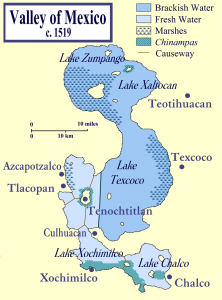Valley of Mexico
Kolb, Dustin
Dustin Kolb is a German researcher who has opted for a Mexican location for Atlantis(a)(b). Somehow or other he arrived at the conclusion that Plato’s description of Atlantis could only have been a reference to America. His then ‘reasoned’ that since the capital of Atlantis was in the middle of Plato’s island, this must have been a reference to Central America! Moving steadily along, he next decided that the concentric rings of the Atlantean capital could only have been an impact crater. He finally settled on the region of Lake Texcoco in the Valley of Mexico as the original home of Atlantis.
His idea of Atlantis in Mexico is not original, having been first proposed over a century earlier by Louis de Launay and has Gene Matlock as arguably its best known modern proponent. I was not convinced by Kolb as he failed to explain either why or how an attack could be launched from Mexico across the Atlantic to the eastern Mediterranean. He also fails to explain how a Mexican Atlantis had control of the western Mediterranean without leaving any archaeological evidence to support such a contention. Finally, his explanation that the ‘elephants’ recorded by Plato were probably “bulls and bison” is, in my opinion, pathetic.
(a) https://atlantisforschung.de/index.php?title=Atlantis_lag_in_Mexiko (German)
(b) https://www.academia.edu/3385512/Atlantis_in_Mexico?email_work_card=view-paper (Ger)
Buelna, Eustaquio,
 Eustaquio Buelna (1830-1907) was a Mexican lawyer, educator and philologist. He believed(a) that the Toltecs and the Aztecs were of the Nahuatl race and were originally from Atlantis, submerged in the Atlantic, but migrated to North America and eventually to the Valley of Mexico via the Gila and Colorado rivers.
Eustaquio Buelna (1830-1907) was a Mexican lawyer, educator and philologist. He believed(a) that the Toltecs and the Aztecs were of the Nahuatl race and were originally from Atlantis, submerged in the Atlantic, but migrated to North America and eventually to the Valley of Mexico via the Gila and Colorado rivers.
Tenochtitlan
Tenochtitlán was the capital city of the Aztec empire, occupying what is now the centre of Mexico City, in what we know as the  Valley of Mexico. At the time of the Spanish invasion in 1521, it has been estimated that its population numbered over 200,000, making it one of the largest cities in the world at the time. It was built on an island in the middle of a lake(a), a feature often found in many ancient Aztec towns and cities.
Valley of Mexico. At the time of the Spanish invasion in 1521, it has been estimated that its population numbered over 200,000, making it one of the largest cities in the world at the time. It was built on an island in the middle of a lake(a), a feature often found in many ancient Aztec towns and cities.
The features of Tenochtitlán have been frequently compared with Venice and its canal system, not to mention the concentric waterways of Atlantis described by Plato. Like Atlantis, it too has its central pyramidal temples as well as bridges and other structures.
Tenochtitlan had a huge marketplace described in Merry E. Wiesner-Hanks’ book, An Age of Voyages [1773]. “Tenochtitlan has a great marketplace where ‘sixty thousand people come each day to buy and sell… Its merchandise included ornaments of gold and silver, lead, brass, copper, tin, stones, shells, bones, and feathers …”(d).
>The pros and cons of Mexico hosting Atlantis are discussed by Lawrence Freeman, author of Beyond the Pillars: a search for Antediluvian civilizations(f), in a 2000 paper(e).<
Edward Ziomek continues to promote the idea of a Mexican Atlantis centred on Tenochtitlán(b) and/or Teotihuacan(c).
(a) https://mitchtestone.blogspot.com/2008/09/island-city-of-tenochtitlan.html
(b) https://www.eupedia.com/forum/archive/index.php/t-9206.html
(c) https://www.flickr.com/photos/10749411@N03/5068038568
(d) Tenochtitlan: The Atlantis of the Ancient Aztec Empire – Pyramidomania (archive.org) *
(e) https://chapala.com/chapala/Oct2000.html *
(f) http://lfreeman.blogspot.com/2006/11/beyond-pillars-search-for-antediluvian.html *
